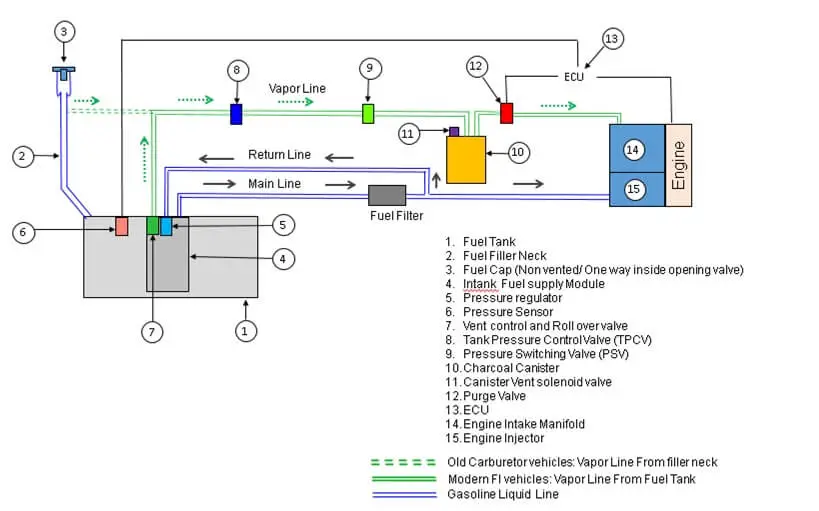The gasoline-driven vehicles essentially have an EVAP (evaporative) emission control system to control the emission of gas vapors into the atmosphere.
Gasoline as we know is a highly volatile organic compound that when exposed to open air, would start evaporating.
An EVAP system usually has a tank pressure sensor, tank pressure control valve, tank vent valve, pressure switching valve, charcoal canister, canister vent solenoid valve, and purge control valve.
Each part has certain defined functions to do, but the charcoal canister can be one of the key items around which the EVAP emission control system is typically built-on.
Often a bad charcoal canister leads to several vehicle-related problems and anyone would think of ways to get rid of the problems related to it.
To delete the charcoal canister, you would need to plug the hose ends connecting the purge control valve and air intake system and connect a differential vent valve to the hose connecting to tank or use a vented gas tank cap with an inbuilt pressure control valve to prevent possible pressure or vacuum increase in the fuel tank.
If you are thinking of charcoal canister deletion, then you are at the right place. Here, you would get to know everything. Stay tuned!
Table Of Contents
What Is The purpose Of The Charcoal Canister?

The function of the charcoal canister is to adsorb the fuel vapors leaving the fuel tank and send them to the engine intake manifold at a suitable time for combustion.
Typically, the fuel system venting takes place through the charcoal canister that serves the purpose of maintaining atmospheric pressure inside the fuel tank.
The fuel vapors which are generated inside the fuel tank traverse the pressure control valve and pressure switching valve and reach the charcoal canister.
The fuel vapors are not sent to the canister as and when it gets generated inside the fuel tank. The tank pressure control valve ensures that the fuel vapor reaches certain pressure before it opens and releases the vapor to enter the charcoal canister.
This is to ensure minimal gas vapor generation since the pressurized fuel tank will generate comparatively fewer fuel vapors than the fully vented one.

The charcoal canister adsorbs and stores these fuel vapors on its charcoal particles and releases just hydrocarbon-free air into the atmosphere.
A charcoal canister typically has 3 ports viz. ‘AIR’ or ‘VENT’, ‘TANK’, and ‘PURGE’. The AIR port is connected to the atmosphere through the charcoal vent solenoid valve whose end is open to the air.
The TANK port is linked to the fuel tank through the tank pressure control valve, and the PURGE port is connected to the purge control valve.
The stored vapors in the charcoal canister are purged to the engine intake manifold by the purge control valve which gets activation signals from the vehicle ECM (Electronic control module) when conditions are favorable for rich fuel conditions during combustion to meet the engine tailpipe emission norms.
When the purge valve opens it applies the engine vacuum to the charcoal canister to pull the vapors to participate in the combustion process.
The ECU performs a series of leaking and venting tests to confirm the integrity of the EVAP system at frequent intervals by operating the pressure switching valve and charcoal vent solenoid valve and also gets pressure inputs from a tank pressure sensor.
Large leak and small leak detection tests are performed and monitored by the ECU by applying a large engine vacuum to the fuel tank and measuring the vacuum inside the fuel tank using the tank pressure sensor.
The charcoal vent solenoid will be closed and purge control valve will be open in this case.
Similarly, a small leak test is to confirm that vacuum decay happens when the purge valve is closed and the charcoal vent solenoid is opened.
This ensures that there is no leak in the EVAP system and that venting and purging are taking place without any issue.
If the EVAP system fails the integrity test, it throws the check engine light (CEL) on the dashboard and will also get the P0447 diagnostic error code and the vehicle will not pass the smoke test if it is applicable.
The EVAP tests are typically applicable for OBD2 (Onboard Diagnostic) vehicles with modern EVAP systems.
If your vehicle is OBD1, then a smoke test may not be applicable for your vehicle. You need to check with local authorities to avoid any legal issues.
Charcoal Canister Deletion? Everything You Need to Know!
Even though a charcoal canister may not be one of the regular maintenance items but sometimes depending upon the vehicle operating conditions it may go bad and would need attention to avoid possible issues.
Often people think of charcoal canister deletion due to one or more symptoms of a bad charcoal canister like,
- Improper venting of fuel system due to a clogged charcoal canister which results in a pressurized fuel tank that gets noticed while opening the fuel cap,
- Poor vehicle performance resulting from clogging of the purge control valve and fuel injectors due to the dislodging of loose charcoal particles through the damaged charcoal filters.
- Fuel smell all around the vehicle or inside the garage resulting from the ineffective charcoal canister.
Steps to delete charcoal canister
- Locate the canister and unplug the hoses from all charcoal canister ports viz. air, tank, and purge port and remove the charcoal canister from its mounting points.
- The open end of the hose which is connected to the canister’s ‘Tank’ port can be connected to a differential vent that has a two-way check valve.
- This shall freely allow ambient air to prevent vacuum generation inside the fuel tank due to fuel consumption but shall release gas vapors generated inside the fuel tank after attaining certain pressure say 0.75 psi. This would prevent the free escape of gas vapors into the atmosphere. This is especially to be done if your vehicle does not have a tank pressure control valve.
- If a differential vent is not available, then you can use a vented fuel tank cap with an in-built pressure control valve. The cap shall release gas vapors after reaching certain pressure but shall allow natural venting when the tank experiences vacuum conditions.
- In some cases, people connect the tank hose end to an inline filter that has cotton or charcoal inside. But once the cotton gets soaked up or charcoal gets saturated, the gas would start coming out and you may smell fuel around your car.
- The open end of the hose which is connected to the canister’s ‘Purge’ port or the hose which goes to the purge control valve to be plugged by bolt and clip arrangement otherwise it would leak the intake manifold vacuum and affect the air-fuel mixture ratio.
- If you have any hose which is connected to other parts like the air intake system, then you may plug the inlet hose end of the intake to prevent a possible vacuum leak.
Possible Issues With The Charcoal Canister Deletion?
If you are deleting charcoal canister then there is a possibility of a few issues as mentioned below.
Check Engine Light
Even after using a vented cap with an in-built pressure control valve or a differential vent with a one-way valve, once the fuel tank reaches certain pressure after the fuel temperature increment, the gas vapors shall be released into the atmosphere and would cause air pollution and the vehicle would throw a check engine light (CEL) on the dash if it needs to satisfy OBD2 emission norms.
Fuel smell
The fuel vapors may not exit the fuel tank immediately but they would escape after a while when the pressure inside the tank increases.
Hence one may experience a fuel smell issue around your car and the smell will be more predominant in an enclosed garage.
Less fuel economy
Your vehicle may have less fuel economy since the fuel vapors escape freely to the atmosphere which is otherwise captured in the charcoal canister and get consumed in the intake manifold during purging.
Possible fire hazard
If you plug the hose end of the tank port and do not use a vented tank cap then there are chances that the fuel tank would build huge pressure and vacuum and there are chances of fuel tank rupture or collapse which may lead to hazardous conditions. Hence everything is to be done carefully so that it doesn’t backfire.
Conclusion
The Charcoal canister is an essential part of an EVAP emission control system to regulate, store and discharge the fuel vapors to the engine under favorable conditions.
Otherwise, these fuel vapors would be vented to the atmosphere and create air pollution.
If you want to delete the charcoal canister since it has gone bad, then you may experience some vehicle issues hence it will be a better choice to replace the bad charcoal canister with a new one instead of deleting charcoal canister.
Deleting charcoal canister is not as per regulations and may invite legal trouble if your vehicle is supposed to have a proper emission control system to prevent air pollution.
If the charcoal canister looks good but still you get some vehicle issues then it is better to scan the DTC diagnostic trouble codes to ensure other vehicle parts are not at fault.
Otherwise, you may be deleting a charcoal canister that does its function properly.
Hope this information supports you in taking the correct decision and would assist in fixing vehicle issues related to the EVAP system.
Happy Motoring!
References
https://www.independentoffroading.com/index.php?threads/evap-canister-delete.86/
https://nastyz28.com/threads/charcoal-canister-delete.229938/
Related Articles
Charcoal Canister Filled With Gas? Ways To Fix!
Can You Bypass Evap Purge Valve? Let’s know the facts!
Can Purge Valve Be Cleaned? Everything You Need To Know!
Vent Valve Vs Purge Valve? What is the difference?


